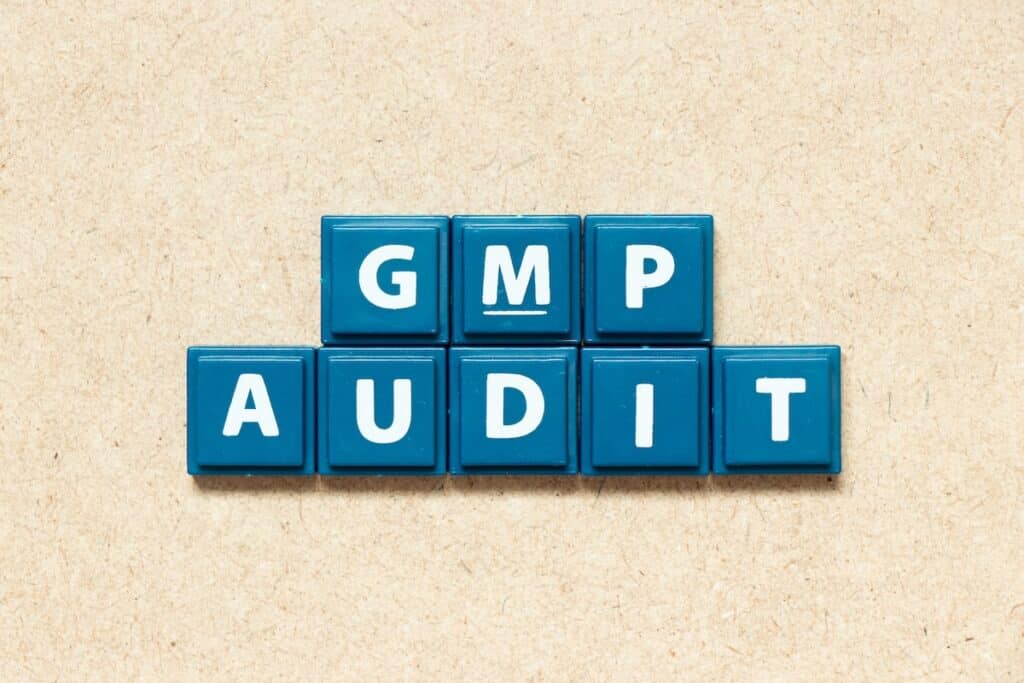Conducting a Good Manufacturing Practices (GMP) audit is essential to ensure that your manufacturing processes meet regulatory standards and maintain high product quality. These audits assess your compliance with GMP guidelines, highlight areas for improvement, and help prevent costly issues like product recalls or regulatory penalties.
Whether you’re in the pharmaceutical, biotechnology, food, or cosmetic industries, understanding the basics of GMP audits, how to prepare, and what to expect during the process is key to success. This article will walk you through the top tips for a successful GMP audit.
Key Takeaways
- GMP audits are vital for ensuring compliance with quality and safety standards, preventing costly penalties, and protecting consumers.
- Thorough preparation, including reviewing previous audit findings and developing detailed SOPs, is key for a successful GMP audit.
- Using technology, like digital audit checklists and real-time monitoring tools, can enhance efficiency and accuracy in the GMP audit process.
Understanding Good Manufacturing Practices (GMP) Audits
GMP audits are critical for ensuring that your manufacturing processes meet regulatory requirements and maintain consistent product quality. These audits assess your compliance with industry-specific GMP standards, which apply across multiple sectors, including pharmaceuticals, biotechnology, cosmetics, and food production.
By ensuring that products meet strict quality and safety requirements, GMP audits help protect consumers and maintain the integrity of your manufacturing processes. While GMP audits are often associated with food safety, they play an equally vital role in other industries, safeguarding against contamination, defects, and non-compliance with regulatory standards.
Are GMP Audits Necessary?
Absolutely! GMP audits are essential for ensuring that your manufacturing processes comply with industry regulations and maintain high-quality standards. Non-compliance can result in severe consequences, including product recalls, financial penalties, and damage to your reputation.
Regular audits help you stay aligned with ever-evolving regulatory standards, not just in food safety but in pharmaceuticals, cosmetics, and other sectors. By maintaining compliance through regular GMP audits, you can prevent costly disruptions and ensure your manufacturing processes consistently meet required standards.
Key Elements of GMP Audits
The key elements of a GMP audit cover a wide range of factors designed to ensure that your facility maintains compliance with quality and safety standards. These include personnel training to ensure employees understand proper hygiene, safety, and quality control practices relevant to your industry, whether it’s pharmaceuticals, biotechnology, cosmetics, or food.
Auditors evaluate the cleanliness and maintenance of the production facility, including critical systems such as water supply, waste disposal, and ventilation. Equipment maintenance is scrutinized to prevent contamination and ensure it operates according to GMP standards. In addition, production process controls are reviewed to ensure that your manufacturing consistently meets both safety and quality benchmarks, reducing the risk of defects or non-compliance.

Preparing for a GMP Audit
Thorough preparation is essential for a successful GMP audit. Start by reviewing all relevant documentation, such as standard operating procedures (SOPs), training records, and previous audit reports, to identify any potential compliance gaps.
Conducting preliminary interviews with key personnel can help highlight any areas that may need attention before the audit begins. It’s also important to communicate the audit plan, timeline, and expectations to all team members involved to ensure everyone is aligned. This proactive approach helps prevent auditors from discovering unexpected issues and ensures a smooth, efficient audit process.
Reviewing Previous Audit Findings
A thorough review of past audit findings is crucial for improving your readiness for the next GMP audit. This step allows you to pinpoint recurring issues and implement corrective actions to address them ahead of time.
Conducting mock audits or practice runs can help identify any potential challenges and ensure your team is well-prepared. In addition, regular GMP training sessions keep employees informed about the latest compliance standards and practices. Setting a clear audit agenda with specific timelines and assigning responsibilities to designated personnel helps streamline the preparation process, ensuring everything is in order when the audit begins.
Developing Standard Operating Procedures (SOPs)
Standard Operating Procedures (SOPs) are critical for outlining the step-by-step instructions needed for consistent manufacturing processes. For a successful GMP audit, having a detailed checklist based on current GMP standards and regulatory requirements is essential.
This checklist should not only cover day-to-day operations but also include documentation and procedural adherence across all departments involved in production. While the specifics of each SOP will vary depending on the industry, the underlying goal is the same: ensuring that all processes meet regulatory quality and safety standards, whether in pharmaceuticals, biotech, cosmetics, or food production.
Organizing Documentation
A well-organized documentation system is key to demonstrating compliance during GMP audits. Proper documentation not only serves as proof of adherence to GMP standards but also helps streamline the audit process by making critical records easily accessible.
Digital documentation tools can greatly enhance your ability to manage, organize, and retrieve documents quickly and efficiently. From production logs and training records to equipment maintenance reports, having everything in order ensures a smoother audit experience and minimizes the likelihood of overlooked issues. By adopting a systematic approach to documentation, your team can ensure all necessary records are readily available for review during the audit.
Conducting Internal GMP Audits
Regular internal GMP audits are essential for maintaining ongoing compliance with regulatory standards. These internal reviews allow your team to identify and address any gaps in compliance before an external inspection occurs.
By conducting routine internal audits, you can pinpoint inefficiencies in processes and implement corrective actions to improve them. This proactive approach fosters a culture of continuous improvement and ensures your manufacturing operations remain in line with current GMP guidelines, whether you’re in pharmaceuticals, biotechnology, cosmetics, or food production.
Setting Up an Internal Audit Team
Establishing an internal audit team is a key step in maintaining GMP compliance. The team should consist of individuals who have received regular, updated training on relevant regulations and procedures.
Regular pre-audit meetings are essential to ensure all team members understand their specific roles and responsibilities, allowing the internal audit to be conducted thoroughly and effectively. A well-prepared team can spot compliance issues early, reducing the risk of external audit failures and driving continuous improvement in manufacturing processes.
Using Checklists for Internal Audits
Using customizable checklists for internal audits improves both the thoroughness and efficiency of the process. These checklists can be tailored to meet the specific GMP requirements of your industry, ensuring that no critical areas are overlooked.
Leveraging digital tools to manage checklists allows for real-time updates, ensuring that all data is accurate and current. This approach not only streamlines the audit process but also enhances the team’s ability to track and address compliance issues quickly.

The On-Site GMP Audit Process
The on-site GMP audit process typically begins with detailed planning, including an opening meeting, document reviews, firsthand observations, and concludes with a written report.
Before the on-site audit, it’s important to review key documents such as quality control records, production logs, and past audit findings. Conducting preliminary interviews with relevant staff can help auditors identify any potential compliance gaps. This thorough pre-audit preparation ensures the audit will focus on critical areas and uncover any issues that need immediate attention, minimizing the chance of unexpected findings during the formal review.
Opening Meeting
The opening meeting is a critical step in setting the tone for a successful GMP audit. During this meeting, the objectives of the audit should be clearly outlined, along with the specific roles of the audit team members.
It’s also an opportunity to review the relevant regulations and industry standards that apply to the product or process being audited. This initial discussion helps ensure that all key personnel understand the scope, purpose, and expectations of the audit, aligning everyone on the goals for compliance and improvement.
Making Firsthand Observations
During the on-site GMP audit, auditors conduct firsthand observations of various aspects of the manufacturing process. This includes evaluating the condition of facilities, equipment, material handling processes, production procedures, and quality control systems.
Auditors also assess packaging, labeling, and personnel training to ensure that all operations meet GMP standards. Firsthand observations are crucial for identifying areas of non-compliance, which could affect product quality or safety. By thoroughly reviewing key areas, auditors can pinpoint any gaps in compliance and recommend corrective actions to address these issues promptly.
Documenting Findings
During the GMP audit, findings should be categorized based on their severity to prioritize corrective and preventive actions. It’s important to document all corrective actions in detail to ensure transparency and accountability throughout the process.
Effective documentation should provide a balanced view, highlighting both strengths and areas for improvement in compliance. This comprehensive approach ensures that the audit results are actionable and can lead to meaningful improvements in manufacturing processes and overall GMP compliance.
Implementing Corrective Actions
Once the GMP audit is complete, implementing corrective actions is crucial for addressing any identified deficiencies and improving processes. Using real-time monitoring tools can help track compliance issues and enable immediate responses, preventing costly penalties and ensuring continuous adherence to regulatory standards.
Effective corrective actions not only resolve current non-compliance issues but also enhance overall product quality and operational efficiency, contributing to long-term improvements in manufacturing practices.
Creating a CAPA Plan
A Corrective Action Request (CAR) must be created to document each identified non-conformance and assign responsibility for corrective actions. Developing a Corrective and Preventive Action (CAPA) plan is essential to address the root causes of these issues and prevent them from recurring.
The CAPA plan should prioritize actions based on their potential impact and ease of implementation. Involving a cross-functional team ensures a comprehensive approach to root cause analysis and the development of sustainable solutions, making corrective actions both effective and long-lasting.
Monitoring Progress
After implementing corrective actions, regular follow-ups are essential to ensure these measures have effectively addressed the identified issues. Establishing key performance indicators (KPIs) helps track the success of corrective actions over time.
Consistent monitoring ensures that your team stays on track with compliance goals and fosters continuous improvement in GMP practices. This ongoing evaluation not only supports sustained compliance but also helps identify opportunities for further optimization in manufacturing processes.

Common Mistakes to Avoid During GMP Audits
There are several common mistakes that can hinder the success of a GMP audit, potentially leading to compliance issues and affecting product quality. Poor preparation, such as not reviewing past audit findings or failing to organize documentation, is a frequent error.
Insufficient employee training is another major issue, as untrained personnel may not follow GMP standards correctly. Addressing these common pitfalls is crucial to maintaining compliance, ensuring high-quality manufacturing, and avoiding unnecessary risks or penalties.
Inadequate Preparation
Failing to adequately prepare for a GMP audit can result in serious consequences, including product recalls, fines, and damage to your company’s reputation. It’s essential to thoroughly review past audit findings to identify recurring compliance issues and areas that need improvement.
Additionally, having well-established audit procedures in place is critical to the effectiveness of the GMP audit. Without a structured approach, important compliance gaps may go unnoticed, leading to costly penalties.
Insufficient Training
Insufficient training is a common issue that can lead to non-compliance during GMP audits. It’s vital to provide employees with adequate training on GMP standards, including proper hygiene, equipment handling, and safety protocols.
Regular training sessions ensure that staff members are aware of current regulations and compliance expectations. Conducting internal audits and incorporating employee feedback into training programs can foster a culture of continuous learning and accountability, improving overall adherence to GMP standards.
Benefits of Regular GMP Audits
Regular GMP audits play a key role in maintaining product consistency, reliability, and quality. These audits ensure that best practices are being followed across all manufacturing operations, which helps meet both regulatory and industry quality standards.
In addition to identifying areas for improvement, regular audits help detect potential compliance issues before they escalate. Utilizing GMP compliance software can further streamline the process, ensuring that your operations keep up with evolving safety and quality standards, regardless of the industry.
Ensuring Regulatory Compliance
Regular GMP audits are essential for ensuring your manufacturing processes comply with FDA regulations and other industry-specific standards. By conducting these audits consistently, organizations can stay ahead of potential regulatory issues and better prepare for formal inspections by bodies like the FDA, EMA, or other relevant authorities.
A proactive approach to GMP audits ensures that operations adhere to current good manufacturing practices (cGMP) and that employees use appropriate safety protocols and protective equipment, safeguarding both product quality and compliance.
Enhancing Continuous Improvement
One of the most significant benefits of GMP audits is the opportunity for continuous improvement. These audits help identify inefficiencies in processes, equipment, and personnel practices, allowing you to make targeted improvements that enhance both quality and efficiency.
By pinpointing areas for cost savings and optimizing procedures, GMP audits foster a culture of continuous improvement within your organization. Regular audits also raise employee awareness about compliance and quality, encouraging them to maintain high standards throughout the manufacturing process.

Utilizing Technology for GMP Compliance
Leveraging digital tools for GMP audits can significantly improve both efficiency and accuracy. Digital solutions provide customizable checklists that streamline the audit process and enhance documentation management.
These tools offer real-time updates, making it easier to track progress and identify areas for improvement. Additionally, many software solutions come with personalized demos and support from experts to help users fully utilize their capabilities, ensuring a smoother audit process and more robust compliance management.
Digital Audit Checklists
Digital audit checklists enhance operational efficiency by streamlining documentation management and improving the speed of corrective actions. They assist in GMP audits by organizing and tracking essential compliance documents, such as SOPs, safety regulations, and staff qualifications, ensuring a comprehensive and organized audit process.
By using digital tools, organizations can maintain consistency over time, reducing errors and improving the overall effectiveness of their compliance efforts.
Real-Time Monitoring
Real-time monitoring through compliance software enables immediate updates and adjustments to manufacturing practices, significantly enhancing the accuracy of data collection during audits. This real-time approach can make the audit process up to five times faster by promptly addressing any non-compliance issues.
In addition to improving the speed of audits, real-time monitoring supports continuous improvement by providing timely insights into compliance status and operational effectiveness, ensuring that corrective actions are taken swiftly and effectively.
Streamline Your Manufacturing with ASC Software
At ASC Software, we understand the challenges of managing complex manufacturing processes while maintaining compliance with regulatory standards like GMP. Our cutting-edge software solutions are designed to simplify your operations, improve efficiency, and enhance visibility across all stages of production. Key features include:
- Real-Time Data Tracking: Monitor every aspect of your manufacturing in real-time to ensure compliance and catch potential issues before they escalate.
- Customizable Workflow Automation: Automate routine tasks and streamline your production workflows to increase efficiency and reduce human error.
- Comprehensive Document Management: Easily organize, access, and audit critical documents like SOPs and production records, ensuring everything is up-to-date and compliant.
- Advanced Reporting and Analytics: Gain valuable insights with detailed reports that help you make data-driven decisions to improve processes and product quality.
- Scalable Solutions: Whether you’re a small operation or a large enterprise, ASC Software grows with you, providing tailored solutions to meet your unique manufacturing needs.
By leveraging ASC Software, you can not only meet regulatory requirements but also drive continuous improvement in quality, productivity, and compliance.
Summary
In conclusion, successful GMP audits are crucial to ensuring that manufacturing processes comply with regulatory and quality standards. By understanding the audit process, preparing thoroughly, conducting internal audits, and leveraging technology like digital tools and real-time monitoring, organizations can maintain compliance while driving continuous improvement.
Regular GMP audits not only safeguard consumer safety but also enhance operational efficiency and product quality. Equip your team, embrace modern compliance tools, and stay committed to excellence in every aspect of your manufacturing process.
Optimize Your Manufacturing Processes with ASC Software
Staying compliant with regulatory standards like GMP is critical, but it doesn’t have to be complicated. ASC Software’s comprehensive solutions streamline your operations, improve documentation management, and provide real-time insights to ensure you’re always audit-ready.
Ready to simplify compliance and enhance efficiency? Schedule a demo today to see how ASC Software can support your manufacturing goals.
Frequently Asked Questions
Why are GMP audits necessary?
GMP audits are essential because they ensure compliance with both industry-specific and regulatory standards. This not only upholds product quality and safety but also helps avoid costly penalties, recalls, or legal consequences. In addition, regular audits promote continuous improvement, helping businesses remain competitive and protect their reputation.
What are the key elements of a GMP audit?
A GMP audit focuses on critical elements such as personnel training, sanitary controls, equipment maintenance, and production process controls. By keeping these areas in check, the audit ensures that your manufacturing processes consistently meet quality and safety standards, reducing risks of contamination or compliance violations.
How can we prepare for a GMP audit?
Preparing for a GMP audit involves reviewing past audit findings, establishing clear and up-to-date SOPs, organizing documentation, and conducting internal audits. This proactive approach ensures that your manufacturing processes are audit-ready, minimizing the chances of unexpected issues arising during the audit.
What common mistakes should be avoided during GMP audits?
To avoid common mistakes during GMP audits, ensure your team is well-prepared by reviewing past audits and conducting regular training sessions. Lack of preparation and insufficient training are common errors that can lead to non-compliance. Properly organizing documentation and scheduling mock audits can prevent these issues from occurring.
How can technology aid in GMP compliance?
Using technology like digital audit checklists and real-time monitoring tools can significantly enhance your GMP compliance efforts. These tools increase efficiency, improve documentation management, and enable immediate adjustments, which ensures continuous compliance and fosters a culture of improvement.




